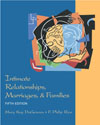The United States has one of the highest divorce rates of any country. Factors
that determine probability of divorce include age at first marriage, premarital
child bearing, religious ties, socioeconomic status, ethnic background, geographic
residence, divorce of parents, and the number of children in the family. Husbands
and wives have different perceptions of the causes of divorce, with some being
the same and with both listing basic unhappiness first. A major component of
marital dissolution is disaffection, or the loss of intimacy and love. Four
considerations enter into the difficult decision to divorce--level of satisfaction,
barriers to divorce, attractiveness of alternatives to the marriage, and intensity
of the emotional pain of the unhappy marriage. Three major alternatives to divorce
are marriage counseling, marriage enrichment programs, and structured separation.
Five types of situations influencing the decision to separate are extreme conflict,
absence of spouse reinforcement, feeling constricted, a situational or midlife
transition, and indecision regarding divorce. No-fault divorce can help lessen
negative consequences thought is thought by some to be a contributing factor
of high divorce rates. Mediators can help in resolving differences. There are
usually adjustments to make to the divorce. Courts consider the best interests
of the children in granting legal and/or physical custody. Joint legal custody
involves sharing of responsibilities and rights by both parents. Visitation
rights are given to the parent noncustodial. Different systems are used to determine
amounts of child-support awards. Divorce can be very difficult for children,
and research has shown that long-term negative effects can continue to show
up in adulthood. |



 2002 McGraw-Hill Higher Education
2002 McGraw-Hill Higher Education